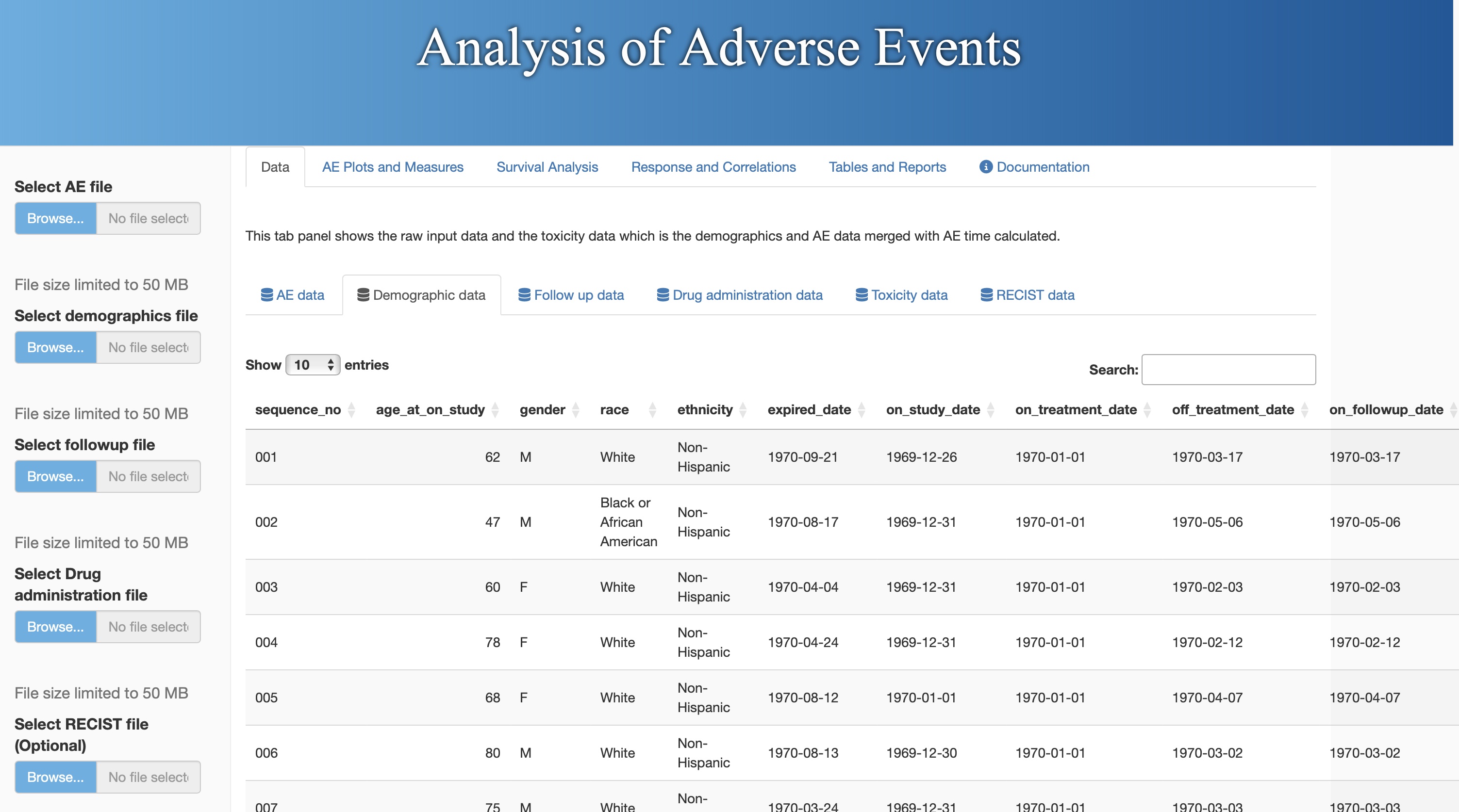
You can install packages directly from Github with a couple R lines of code.
# Installing from GitHub
remotes::install_github("https://github.com/dungtsa/AdverseEvents", build_opts = NULL)
# Loading MoffittFunctions and Example Dataset
library(AdverseEvents)This is an application for analysis of Adverse Event (AE) data from Oncore. The application requires 4 data sets (a 5th tumor measurement file, with RECIST format as response is optional for additional plots). In the OnCore biostats console download the clinical trial data from the “Data Export” page by selecting the protocol number, clicking “Use Descriptions” in export options, and finally click export. See the Oncore data export screen shot.
Once installed run the function runAEapp() to launch a browser with the application and demo data will be loaded.
RECIST (Response Evaluation Criteria in Solid Tumors) is a set of standardized criteria used to assess how well a tumor responds to treatment in clinical trials, particularly for cancer therapies. These criteria provide a consistent method for measuring tumor size and determining changes in tumor burden over time. Developed by an international collaboration of cancer organizations, RECIST ensures that tumor response can be compared across different studies.
Overall, RECIST is a critical tool in oncology research and clinical practice, guiding decisions about patient care and drug approval.
If using tumor measurement/RECIST data the each subject must have baseline measures and follow up measure for the target lesions. The response should be one of the following:
[1] “Baseline (BL)”
[2] “Stable Disease (SD)”
[3] “Progressive Disease (PD)”
[4] “Partial Response (PR)”
[5] “Not Evaluable (NE)”
This is the home page (data tab), on the left upload the data. There are multiple tabs to view each of the raw uploaded data sets and the toxicity data is constructed from merging the uploaded data.

On the data page there are 5 sub-tabs:
Screen shot of the demographic data:

The next tab panel is the AE Plots and Measures page. This tab panel contains a swimmers plot of adverse events and tables of AEs. It also provides download buttons to save the plots and data. The AE measures sub-tab contains the data with the calculated AE metrics used in all other tabs for analysis. One must click “Calculate measures” before the Survival analysis and correlation and response tests can be done.
On the data page there are 4 sub-tabs:
This data set contains all the AE variables for analysis on subsequent tabs. It creates 18 variables, 6 for all grade AEs, 6 for low grade (1,2) and 6 for grade 3 AEs. Half of the AE variables are calculated for all AEs and half are calculated for treatment related AEs.
The duration is measured in days these are continuous measures and are the total number of days with an AE. Fre denotes the frequency of AEs. Occurrence is the unique number of occurrences.
Entering a number in the “Early AE Time Point” box will use that time as a cutoff. Example: if 30 is used only AEs in the first 30 days will be used.
This tab panel allows for survival analysis in the form of Cox PH models for all the adverse event metrics. Kaplan-Meier (KM) plots for overall survival (OS) and progression free survival (PFS) can be selected, as well as box plots of the AE metrics by outcome (partial response, stable disease, progressive disease).
The Coxph measures sub-tab displays the results of Cox PH models for all AE metrics: original continuous measure (labelled .y) and dicotomized as an indicator (ie. > 0, labelled .bin). Both for OS and PFS. Please click the ‘Run Coxph models’ button
The forest plot sub-tab displays forest plots for OS and PFS for all the AE metrics. The analysis builds on the Coxph measures tab analysis but it includes 6 more AE metrics for the unique number of AEs. It also can run the models on particular types of adverse events, specified in the drop down box under “Select plot to view”. This sub-tab also includes a table of the results.
This panel has two sub-panels.
The response tests tab runs t-tests comparing the AE metrics between the disease control group (complete response + partial response + stable disease) vs progressive disease groups (DC vs PD), partial response vs progressive disease groups (PR vs PD), and stable disease vs progressive disease groups (SD vs PD). Bar plots of p values are displayed along with a table of results (p value and difference) by AE type. Similar to the forest plot panel there is a drop box for AE category.
The correlation tab displays a bar plot of the Pearson’s correlation coefficient for each AE metric with treatment time. There are also two tables. A text table with the AE category, AE type, and a summary of which type of metric has a negative or positive correlation with treatment time. A second table of numeric results is also displayed and both tables are downloadable.
These sub tabs produce text tables summarizing the relationship between the AE metrics and OS and PFS by AE category and AE type. The survival analysis and response tests must be run before these tables will be displayed. Each table can be downloaded as a CSV file. The summary report sub-tab is a pdf that can be downloaded.